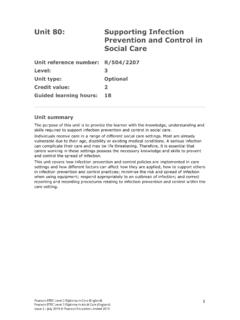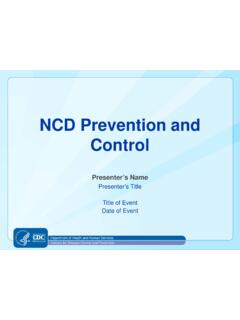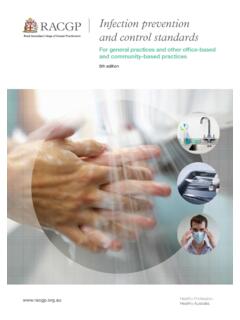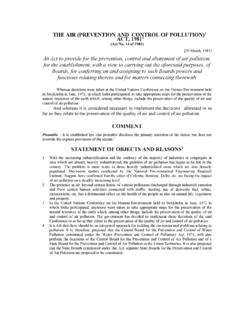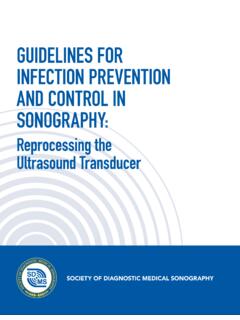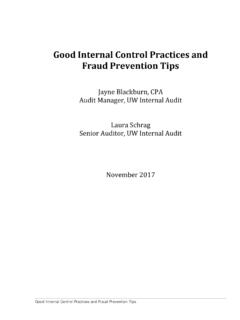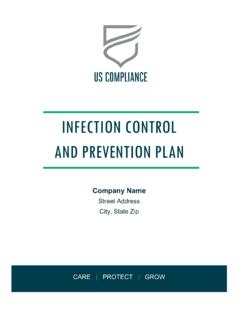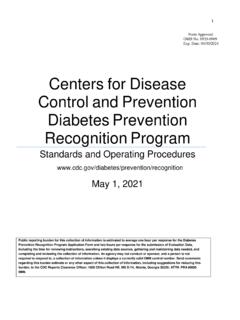Transcription of “CDC’s COVID 19 Infection Prevention and Control ...
1 CDC s COVID -19 Infection Prevention and Control Recommendations (2021), downloaded from on April 27, 2021 4/27/2021 Infection Control : Severe acute respiratory syndrome coronavirus 2 (SARS-CoV-2) | Infection Prevention and ControlRecommendations for Healthcare Personnel During theCoronavirus Disease 2019 ( COVID -19) PandemicUpdated Feb. 23, 2021 PrintSummary of Recent ChangesCDC has Updated Healthcare Infection Prevention and Control Recommendations in Response to COVID -19 Vaccinationin healthcare of February 10, 2021 Updated the Implement Universal Use of Personal Protective Equipment section to expand options for sourcecontrol and patient care activities in areas of moderate to substantial transmission and describe strategies forimproving t of facemasks.
2 De nitions of source Control are included at the end of this a reference to Optimizing Personal Protective Equipment (PPE) Supplies that include a hierarchy ofstrategies to implement when PPE are in short supply or Previous UpdatesUpdates as of February 10, 2021 BackgroundThis interim guidance has been updated based on currently available information about COVID -19 and the current situationin the United States. New recommendations in this updated guidance are noted in the summary of changes above; allrecommendations are organized into the following sections:Recommended Infection Prevention and Control (IPC) practices for routine healthcare delivery during the pandemicRecommended IPC practices when caring for a patient with suspected or con rmed SARS-CoV-2 infectionThis guidance is applicable to all settings where healthcare is delivered.
3 This guidance is not intended for non-healthcaresettings ( , restaurants) OR for persons outside of healthcare settings. For information regarding modes of transmission,clinical management, air or ground medical transport, or laboratory settings, refer to the COVID -19 Key Resources:Strategies to Optimize the Supply of PPE and EquipmentCriteria for Return to Work for Healthcare Personnel with Suspected or Con rmed COVID -19 (Interim Guidance) COVID -194/27/2021 Infection Control : Severe acute respiratory syndrome coronavirus 2 (SARS-CoV-2) | ()Strategies to Mitigate Healthcare Personnel Sta ng ShortagesInterim Guidance for Risk Assessment and Work Restrictions for Healthcare Personnel with Potential Exposure toCoronavirus Disease 2019 ( COVID -19)Discontinuation of Transmission-Based Precautions and Disposition of Patients with COVID -19 in Healthcare Settings(Interim Guidance)Improve the Fit and Increase the Filtration of Your Mask to Help Stop the Spread of COVID -19 1.
4 Recommended routine Infection Prevention and Control (IPC) practicesduring the COVID -19 pandemicCDC recommends using additional Infection Prevention and Control practices during the COVID -19 pandemic, along withstandard practices recommended as a part of routine healthcare delivery to all patients. These practices are intended toapply to all patients, not just those with suspected or con rmed SARS-CoV-2 Infection (See Section 2 for additional practicesthat should be used when caring for patients with suspected or con rmed SARS-CoV-2 Infection ). Facilities should developpolicies and procedures to ensure recommendations are appropriately applied in their setting ( , emergency department,home healthcare delivery).
5 These additional practices include:Implement Telehealth and Nurse-Directed Triage ProtocolsContinue to use telehealth strategies to reduce the risk of SARS-CoV-2 transmission in healthcare settings whilemaintaining high quality patient scheduling appointments for routine medical care ( , annual physical, elective surgery):Advise patients that they should put on their own well- tting form of source Control (see Implement UniversalSource Control Measures for more details) before entering the patients to call ahead and discuss the need to reschedule their appointment if they have symptoms ofCOVID-19 within the 10 days prior to their appointment, if they have been diagnosed with SARS-CoV-2 infectionwithin the 10 days prior to their appointment, or if they have had close contact with someone with suspected orcon rmed SARS-CoV-2 Infection within 14 days prior to their scheduled scheduling appointments for patients requesting evaluation for possible SARS-CoV-2 Infection .
6 Use nurse-directedtriage protocols to determine if an appointment is necessary or if the patient can be managed from the patient must come in for an appointment, instruct them (or their responsible party if they are unable tocommunicate) to take appropriate preventive actions ( , follow triage procedures, put on their own well- ttingform of source Control before entry and throughout their visit or, if a well- tting form of source Control cannot betolerated, hold a tissue against their mouth and nose to contain respiratory secretions) and immediately informtriage personnel upon arrival ( , call from car)
7 So they can be placed in an examination and Triage Everyone Entering a Healthcare Facility for Signs and Symptoms of COVID -19 Although screening for symptoms will not identify asymptomatic or pre-symptomatic individuals with SARS-CoV-2 Infection ,symptom screening remains an important strategy to identify those who could have COVID -19 so appropriate precautionscan be steps to ensure that everyone adheres to source Control measures and hand hygiene practices while in ahealthcare facilityPost visual alerts ( , signs, posters) at the entrance and in strategic places ( , waiting areas, elevators,cafeterias) to provide instructions (in appropriate languages) about wearing a well- tting form of source Control andhow and when to perform hand supplies for respiratory hygiene and cough etiquette, including alcohol-based hand sanitizer (ABHS) with60-95% alcohol, tissues, and no-touch receptacles for disposal, at healthcare facility entrances, waiting rooms, andpatient and monitor points of entry to the facility.
8 -- - - - 4/27/2021 Infection Control : Severe acute respiratory syndrome coronavirus 2 (SARS-CoV-2) | a process to ensure everyone (patients, healthcare personnel, and visitors) entering the facility is assessed forsymptoms of COVID -19, or exposure to others with suspected or con rmed SARS-CoV-2 Infection and that they arepracticing source could include (but are not limited to): individual screening on arrival at the facility; or implementing anelectronic monitoring system in which, prior to arrival at the facility, people report absence of fever and symptomsof COVID -19, absence of a diagnosis of SARS-CoV-2 Infection in the prior 10 days, and con rm they have not beenexposed to others with SARS-CoV-2 Infection during the prior 14 can be either measured temperature F or subjective fever.
9 People might not notice symptoms offever at the lower temperature threshold that is used for those entering a healthcare setting, so they shouldbe encouraged to actively take their temperature at home or have their temperature taken upon reliable temperature readings is a ected by multiple factors, including:The ambient environment in which the temperature is measured: If the environment is extremely hot orcold, body temperature readings may be a ected, regardless of the temperature-taking device that calibration of the thermometers per manufacturer standards: Improper calibration can lead toincorrect temperature usage and reading of the thermometers: Non-contact infrared thermometers frequently used forhealth screening must be held at an established distance from the temporal artery in the forehead totake the temperature correctly.
10 Holding the device too far from or too close to the temporal artery a ectsthe manage anyone with suspected or con rmed SARS-CoV-2 Infection or who has had contact with someone withsuspected or con rmed SARS-CoV-2 Infection :Healthcare personnel (HCP) should be excluded from work and should notify occupational health services toarrange for further should be restricted from entering the facility and be referred for proper should be isolated in an examination room with the door an examination room is not immediately available, such patients should not wait among other patients seeking a separate, well-ventilated space that allows waiting patients to be separated by 6 or more feet, with easyaccess to respiratory hygiene some settings.










